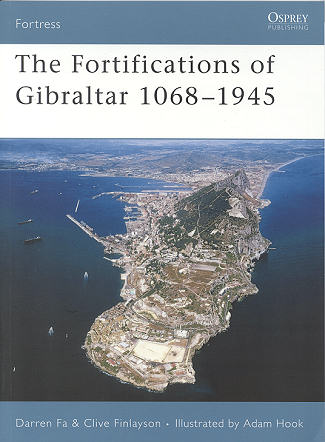 Solid as
the Rock of Gibraltar.
Solid as
the Rock of Gibraltar. |
itle: |
The Fortifications of Gibraltar 1068 - 1945 |
|
Author: |
Darren Fa & Clive Finlayson, illustrated by Adam Hook |
|
Publisher/Distributor |
Osprey Publishing |
|
Price |
$16.95 MSRP |
|
Reviewer: |
|
| Notes: |
64 pages, 7¼ x 9¼ inches, softbound ISBN: 1-84603-016-1 |
 Solid as
the Rock of Gibraltar.
Solid as
the Rock of Gibraltar.
A term originated by the British in the early 1800s and one used by a US Insurance company, the Rock is not a solid as one might think, thanks to an energetic episode of tunneling by the British during much of their ownership of this tiny peninsula.
Originally, it was fortified by Spanish Muslims against attacks from other Muslims, who eventually overran the fortifications and went on to add more fortifications against Spanish Christians, who themselves eventually captured the Rock in the mid 1400s.
Basically these fortifications were designed to out-last various sieges against Gibraltar. Siege warfare was the standard means of warfare until the 20th century, and even then it played a part in a number of important battles. Several of these sieges of Gibraltar lasted for more than a year. Even though successive Spanish rulers increased and improved the fortifications, it eventually fell (during another siege) to an Anglo-Dutch fleet in 1704 and became part of the British Empire in 1713.
Once the British had it, defenses were again improved, though slowly. Much of the tunneling into the rock was by the British who did it in various stages over the years, with the greatest amount of stone moved during the early years of WWII.
With the end of the war, the reality that massive fortifications were no longer a viable means of defense meant that no more construction of that type went on in Gibraltar and eventually, some of these fortifications were abandon and turned over to public use.
This book takes an in-depth look at what was done over the centuries in terms of fortifying Gibraltar. Even today you can see parts of the original forts from nearly a thousand years ago. The authors provide a clear story of how things progressed through period drawings, photographs and the superb artwork of Adam Hook
Overall, this is a superb book on what has to be one of the most interesting and fortified pieces of real estate on the planet. Highly recommended for all.
October 2006
For more on the complete line of Osprey books, visit www.ospreypublishing.com or contact them at Osprey Direct, PO Box 140, Wellingborough, Northants, NN8 2FA, UK. In the US, it is Osprey Direct at 44-02 23rd St, Suite 219, Long Island City, NY 11101., where you can get a catalogue of available books.
If you would like your product reviewed fairly and quickly by a site that has over 325,000 visitors a month, please contact me or see other details in the Note to Contributors.